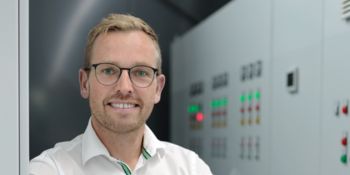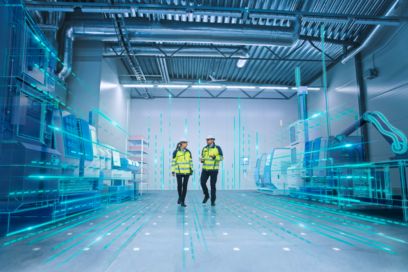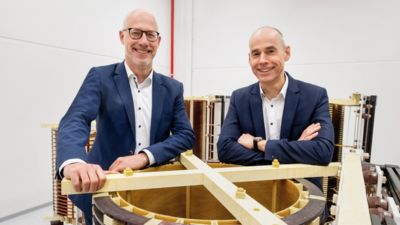Direct current with a passion Local DC power grids can generate energy savings of up to 20%, make the electricity generated directly storable, and require far less resources for their construction.
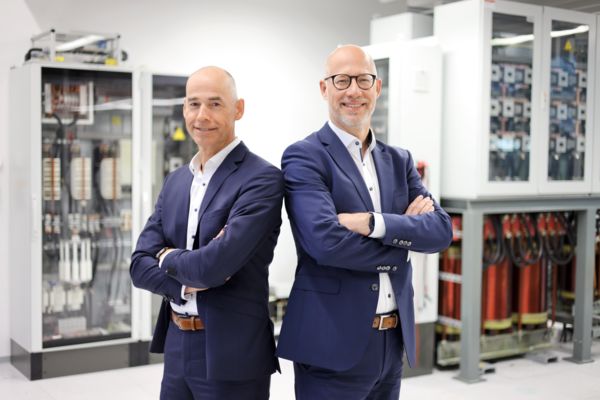
The DC twins
They are the figureheads of DC technology at Phoenix Contact. Martin Wetter and Christian Helmig are firmly committed to the Phoenix Contact mission statement, the All Electric Society. They are also convinced that direct current can make a valuable contribution to the success of the sustainable energy transition.
It is everywhere
We are constantly surrounded by direct voltage in everyday life. “Every electrical device that has a display uses direct current – from washing machines and smartphones to car electronics. Practically ally electric drives work with direct current. Every single battery stores direct current. There are very few appliances, such as old toasters and clothes irons, that directly use alternating current”, explains Martin Wetter.
Christian Helmig adds, “With the advent of renewable energy generators, especially solar, direct voltage has become a big issue again. Whether in solar panels or wind turbines, the captured energy is first converted into direct current. And in electric vehicles, batteries with direct current drive the wheels”.
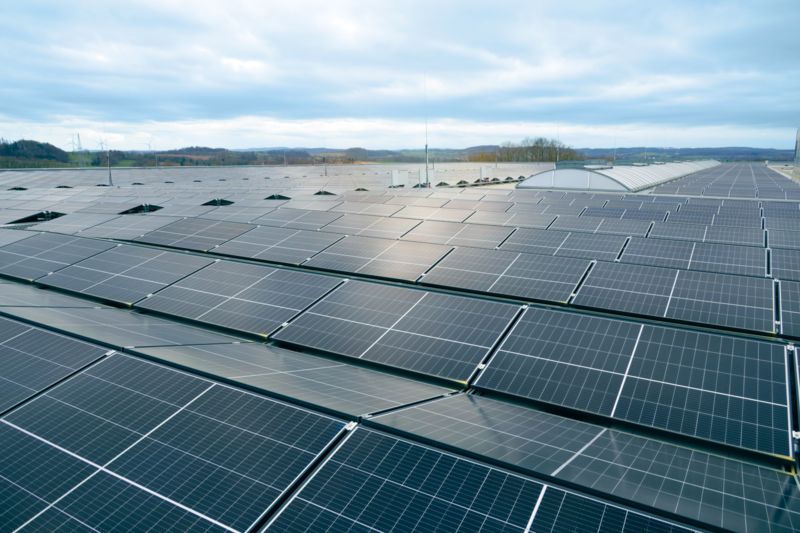
Solar field on the roof of the Phoenix Contact All Electric Society Factory
Advantage direct current
There are tangible arguments that play into the hands of Thomas Alva Edison’s upcoming successors: efficiency, storability, and resources. It is immediately obvious that with every transformation of energy, part of it is lost as heat. When electricity is generated by wind or the sun, it is initially available as DC voltage. The conversion to alternating current “eats up” around 20 percent of the original energy. This loss can be avoided if we operate in a world of DC electricity.
The second advantage is recuperation, i.e., the use of excess kinetic energy. “This is particularly easy with direct current. This is not only important for e-mobility but also in many industrial areas, such as high-bay warehousing systems and industrial robots. Energy is recovered when the movement is reduced”, adds the Innovation Manager, Wetter. “Efficiency is therefore one of the central issues when it comes to increasing the use of direct current.”

DC electricity flows from the charging stations into the traction batteries of electric vehicles
The ability to store it directly is another advantage. Energy from batteries is direct current. Direct current systems can store and retrieve energy directly in batteries without conversion. The complexity of the systems is decreased, which in turn leads to increased efficiency.
The next advantage is the conservation of resources, which begins with saving material, because the copper cables required have significantly smaller cross-sections. And the required connected load, i.e., the amount of electrical energy that the grid operator contractually provides, can be around two-thirds lower than with a conventional AC connection. “This immediately saves money, even before a machine runs”, explains Christian Helmig.

Dr. Martin Wetter explains the advantages of AC electricity
Advantage alternating current
The advantages of alternating current come into play in terms of long-distance power transmission. Dr. Wetter explains, “If I want to transmit a certain amount of power, I need current multiplied by voltage. If I want to transmit a lot of power, I have to increase the current or voltage or both. However, the transmission losses along such lines depend solely on the current. In fact, they increase quadratically, which means that twice the current equals four times the losses. This is why we transmit high powers over long distances using alternating current with high voltages. It minimizes the transmission losses. The conversion is simple and extremely reliable with the appropriate transformers”. Alternating current has therefore become standard in the classic technology of distribution grids with a few large power stations and a star-configuration distribution grid.
The alternating current also scores points when it comes to handling. Martin Wetter says, “Actually, there is nothing that would not work with direct current. What we have achieved in the alternating current sector, however, is an extremely high safety standard. In comparison, around 3,000 people die in road traffic accidents every year in Germany alone. But there are just 30 deaths from electric shocks, despite the enormous prevalence”.

Dr. Christian Helmig explains the differences between DC and AC
Why is it that working with direct current is still the domain of specialists? Christian Helmig explains. “The real difference between DC and AC in everyday life is the lack of the voltage zero point. If a device in operation is disconnected from the mains in an AC voltage grid, an electric arc is generated. But you hardly notice it, as it only lasts a fraction of a second. You have to be much more vigilant with direct current. Disconnecting a live device powered by direct voltage from the mains triggers a dangerous electric arc, which poses a massive risk to both the user and the material. This is why one of our product development goals is to achieve a similar level of safety for direct current technology as end users are accustomed to with alternating current.”

ArcZero – the connectors for DC power grids
Cooperation makes DC powerful
This is where Martin Wetter comes in. “Thanks to new power electronics, we now have options to harness the advantages of DC voltage again. And we have developed our first products that are specifically aimed at the direct use of direct current. But there is still a lack of standardization”.
Dr. Helmig adds, “Our ArcZero, for example, is the first connector that we have developed just for DC. A circuit that recognizes the contact is integrated. If I pull the connector under load, an electric arc is also created here, but it is only minimal because the electricity triggers the circuit”.
Wetter explains, “This demonstrates why we cannot switch everything over to DC straight away. A simple plug and socket pair is much more complex in design to achieve the same result. In simple terms, the world of alternating current is established. We are therefore also founding members of the Open Direct Current Alliance (ODCA), in which more than 70 companies have already joined forces to develop standards for devices. The system concept is more important than individual competition between innovations”.

Dr. Helmig and Dr. Wetter are certain of DC
Summary
Dr. Helmig is confident. “As the number of showcases increases, it will become easier and easier to use this technology. In the meantime, customer interest is constantly increasing. Many of our industry customers want to know more about the experiences we are currently gaining at the All Electric Society Factory and also want to visit us”.
The two innovators are convinced of the success of their mission. “We believe that this technology makes sense. The advantages are clear. It fits perfectly with our vision of an All Electric Society, so the products to be developed are also a worthwhile investment in the future”.
Connect with our experts


